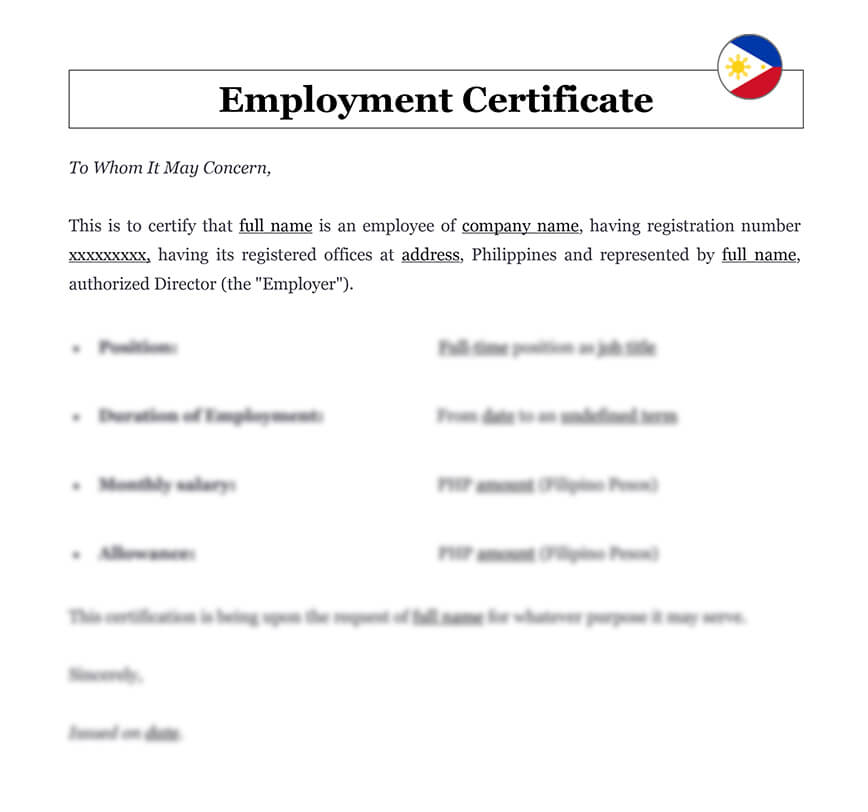
This Employment Certificate is used to attest to the job history of a current or former employee.

Word Document (.docx)

Ready to use legal template
Work on without any hassle
Compliant with Filipino law
Ready to use legal template
Work on without any hassle
Compliant with Filipino law
Employment Certificates, also known as Certificates of Employment (COE), are important documents that provide proof of a person’s employment history in the Philippines. These certificates are commonly required by government agencies, financial institutions, and other organizations as part of their application processes. The certificate typically contains important information such as the employee‘s job title, start and end dates of employment, and salary information. In addition to providing proof of employment, COEs can also be used to verify a person’s income, which is often required for loan applications an other contracts. It is important to note that the Employment Certificate is available when an Employment Contract has been completed. It is also possible to receive the employment certificate after an Employment Termination.
An Employment Certificate in the Philippines is a legal document that serves as proof of a person’s employment status in a company or organization. It contains relevant information about the employee, such as their job title, job description, salary, and duration of employment. The certificate is issued by the employer upon the request of the employee, and it is often used as a requirement for various purposes, such as loan applications, visa applications, and job applications.
In the Philippines, Employment Certificates are regulated by the Department of Labor and Employment (DOLE) and are required by law to be issued to employees upon separation from their job or when they request one. The certificate may also include information about the employee’s performance and conduct during their employment, as well as any benefits they are entitled to receive, such as sick leave, vacation leave, and other statutory benefits.
An Employment Certificate serves as proof of an individual’s employment history and status, which can be used to verify their qualifications and credentials to potential employers, lenders, and other organizations.
Under the Labor Code of the Philippines, employers are required to issue Employment Certificates to their employees upon request or separation from employment. Failure to comply with this requirement can result in penalties and legal consequences for the employer.
Employment Certificates may also contain information about an individual’s performance, accomplishments, and skills developed while in their previous job. This information can be useful in demonstrating their experience and qualifications for future job opportunities and career advancement.
Employment Certificates may also contain information about the employee’s entitlements and benefits, such as unused leaves, allowances, and other statutory benefits. These details can be useful in ensuring that the employee receives the benefits they are entitled to.
Having an Employment Certificate shows that an individual is a credible and trustworthy candidate, as they have provided evidence of their previous employment history and the quality of their work. This can help to build trust with potential employers and increase their chances of being hired for a job.
1. Obtain the necessary information:
Collect the necessary information from the employee, such as their name, position, job description, salary, date of employment, and other relevant details.
2. Format the certificate:
Use a standard template or create a format for the certificate that includes the company logo, letterhead, and other relevant information.
3. Write the content:
Write the content of the Employment Certificate using professional language and clear and concise sentences. Include the employee’s job title, job description, employment period, and other relevant details.
4. Include any additional information:
Include any additional information, such as the employee’s performance, attendance, conduct, and other commendations or awards received.
5. Proofread and edit:
Review the certificate for any errors or typos and make any necessary corrections.
6. Print and sign:
Print the certificate on company letterhead and sign it. If necessary, have it notarized or authenticated by a government agency.
7. Provide the certificate to the employee:
Give the original copy of the Employment Certificate to the employee and keep a copy for your records.
It’s important to note that the specific requirements for an Employment Certificate may vary depending on the purpose or context of its use. In some cases, the certificate may need to be authenticated or notarized by a government agency for it to be recognized as a valid document. It is also possible to call upon Filipino lawyers to ensure the validity of the document and compliance with the regulations.